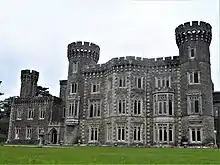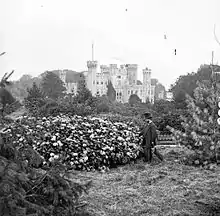Johnstown Castle
Johnstown Castle is a Gothic Revival castle located in County Wexford, Ireland.[1][2][3]
| Johnstown Castle | |
|---|---|
| Native name Irish: Caisleán Bhaile Sheáín | |
 | |
| Type | Castle |
| Location | Johnstown, Murntown, County Wexford, Ireland |
| Coordinates | 52.294042°N 6.505436°W |
| Built | late 12th century (original building) 1836–1872 (current building) |
| Architectural style(s) | Gothic Revival |
| Owner | Irish Heritage Trust |
 Location of Johnstown Castle in Ireland | |
Location
Johnstown Castle is located on the Johnstown Castle Estate, a 150 acres (61 ha) estate, located off the road between Murntown and Rathaspeck, 5.5 km (3.4 mi) southwest of Wexford town.
History

The first castle built on the estate was a tower house built in the late 12th century by the Esmonde family, Normans who came to southeast Ireland from Lincolnshire in the 1170s after the Norman invasion of Ireland (1169).[4] They also built a tower house, which still stands, at Rathlannan immediately to the south.[5]
Oliver Cromwell spent a night on the estate in 1649, prior to the October 1649 Sack of Wexford. His Roundhead army used the land around Johnstown Castle to prepare. The Esmondes, Catholics, were expelled during the Cromwellian years.
Johnstown Castle was bought by the Grogan family in 1692.
Owner Cornelius Grogan was hanged for his part in the 1798 Rebellion; he had been commissary-general for the United Irishmen.[6] In 1810 the estate was restored to his brother John Knox Grogan, who, with his son, Hamilton Knox Grogan-Morgan, created Johnstown Castle as it stands today, on the "bones" of the Norman tower house.[7][8] Daniel Robertson designed the Gothic Revival castle and parts of the surrounding land.[9] By 1863, the demesne was divided in two, with a deer park in the north and the castle, pleasure grounds, farm and two artificial lakes to the south.[10] By 1836–1872 the building was finished.[11]
The Grogans later married into the ancient FitzGerald family.
During the First World War, Royal Naval Air Service airships were based at Johnstown Castle, and were primarily used to deal with the U-boat threat, but with limited success.[12]
Lady Maurice FitzGerald (née Lady Adelaide Jane Frances Forbes, 1860–1942), wife of Lord Maurice FitzGerald (son of Charles FitzGerald, 4th Duke of Leinster), was the last owner to live in the house.[13]
In 1945, Maurice Victor Lakin gave the estate to the Irish state in lieu of taxes. It was taken over by Teagasc and used for agricultural research, while the castle was used for offices and laboratories before opening to the public in 2019. Peter Pearson of the Irish Heritage Trust worked on conserving and restoring the building.[7]
In 2007, a temporary opera house was erected in the castle, to host the Wexford Festival Opera.
Castle
 Frontal view
Frontal view Terrace with statues
Terrace with statues Castle reflected in the lake
Castle reflected in the lake Lake and rhododendrons
Lake and rhododendrons
A Gothic Revival castle of 4 storeys. Interior goods include the "Apostles' Hall", with wood carvings of saints, as well as oil paintings, carved oak hall benches, mahogany billiard tables, dressing tables, upholstered sofas, fire grates and brass fenders.
A servants' tunnel, 86 metres (282 ft) in length, runs from the meat house to the kitchens.[14]
The former stable yard houses the Irish Agricultural Museum.
References
- "Johnstown Castle".
- Gaul, Liam (3 November 2014). Johnstown Castle: A History: A History. The History Press. ISBN 9780750959018 – via Google Books.
- Gerrard, David (6 February 2004). The Hidden Places of Ireland. Travel Publishing Ltd. ISBN 9781904434108 – via Google Books.
- Sheehy, Terence (6 November 1986). Journey through Ireland. Gallery Books. ISBN 9780831752613 – via Google Books.
- Lewis, Samuel (6 February 1840). "A topographical dictionary of Ireland: comprising the several counties, cities, boroughs corporate, market, and post towns, parishes and villages ... : With an appendix describing the electoral boundaries of the several bouroughs as defined by the act of the 2d. and 3d. of William IV". Lewis – via Google Books.
- Richards, Elizabeth (6 February 1999). The Diary of Elizabeth Richards (1798-1825): From the Wexford Rebellion in Ireland to Family Life in the Netherlands. Uitgeverij Verloren. ISBN 9789065501691 – via Google Books.
- "Johnstown Castle opens to the public for the first time next month - here's a sneak preview". independent.
- Wallace, Arminta. "Restoration drama at Wexford's fairy tale Johnstown Castle". The Irish Times.
- "Johnstown Castle". 3 June 2014.
- "Johnstown Castle Estate". www.discoverireland.ie.
- "Capturing the castle: Johnstown Castle in County Wexford is well worth checking out". www.irishexaminer.com. 24 June 2019.
- Furlong, Nicholas and John Hayes. County Wexford in the Rare Oul' Times. Vol. IV. 1910–1924. Wexford: Old Distillery Press, 2005. ISBN 0-9512812-3-2,
- "Take a tour of Wexford's Johnstown Castle - opening to the public in Spring 2019". www.irishexaminer.com. 1 September 2018.
- "About". Johnstown Castle.